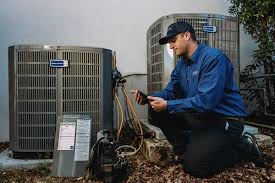Servicing an HVAC system is an essential part of maintaining a comfortable and healthy indoor environment. Regular maintenance can extend the lifespan of the system, improve its efficiency, and prevent breakdowns and costly repairs. Here are the steps to service an HVAC system:
Turn off the power –
Before servicing any part of the HVAC system, it is essential to turn off the power to prevent electrical shock. Locate the circuit breaker that controls the HVAC system and turn it off.
Check the air filter –
The air filter is an essential component of the HVAC system that helps remove dust and other particles from the air. A clogged or dirty air filter can reduce the efficiency of the system and lead to poor indoor air quality. Check the air filter and replace it if it is dirty or clogged.
Inspect the ductwork –
The ductwork is the network of pipes that distribute air throughout the building. Check the ductwork for signs of damage or leaks, such as loose connections, holes, or tears. Seal any leaks with duct tape or mastic.
Check the condenser coil –
The condenser coil is located outside the building and removes heat from the refrigerant. Check the condenser coil for signs of dirt or debris, which can reduce its efficiency. Clean the condenser coil with a soft brush or compressed air.
Check the evaporator coil –
The evaporator coil is located inside the building and cools the air as it passes over it. Check the evaporator coil for signs of dirt or debris, which can reduce its efficiency. Clean the evaporator coil with a soft brush or compressed air.
Check the refrigerant level –
The refrigerant is the fluid that absorbs heat from the indoor air and releases it outside. Check the refrigerant level and add more if necessary. Low refrigerant levels can reduce the efficiency of the system and cause it to overwork, leading to breakdowns and costly repairs.
Check the thermostat –
The thermostat controls the temperature of the building and communicates with the HVAC system. Check the thermostat and replace the batteries if necessary. Test the thermostat to ensure that it is communicating with the HVAC system correctly.
Check the electrical connections –
The electrical connections are the wires that power the HVAC system. Check the electrical connections for signs of damage or wear, such as frayed wires or loose connections. Tighten any loose connections and replace any damaged wires.
Check the blower motor –
The blower motor is the component that circulates the air through the ductwork. Check the blower motor for signs of wear or damage, such as noisy or slow operation. Lubricate the blower motor if necessary and replace it if it is damaged.
Test the system –
Once all the components of the HVAC system have been inspected and serviced, turn on the power and test the system. Check the airflow and temperature of the air coming from the vents. Listen for any unusual noises or vibrations, which could indicate a problem.
Schedule regular maintenance –
Regular maintenance is essential to keep the HVAC system operating efficiently and prevent breakdowns and costly repairs. Schedule regular maintenance with a professional HVAC technician, who can perform more in-depth inspections and repairs.Service HVAC System
In conclusion, servicing an HVAC system is an essential part of maintaining a comfortable and healthy indoor environment. Regular maintenance can extend the lifespan of the system, improve its efficiency, and prevent breakdowns and costly repairs. By following these steps and scheduling regular maintenance with a professional HVAC technician, you can ensure that your HVAC system operates efficiently and provides a comfortable and healthy indoor environment. Service HVAC System

